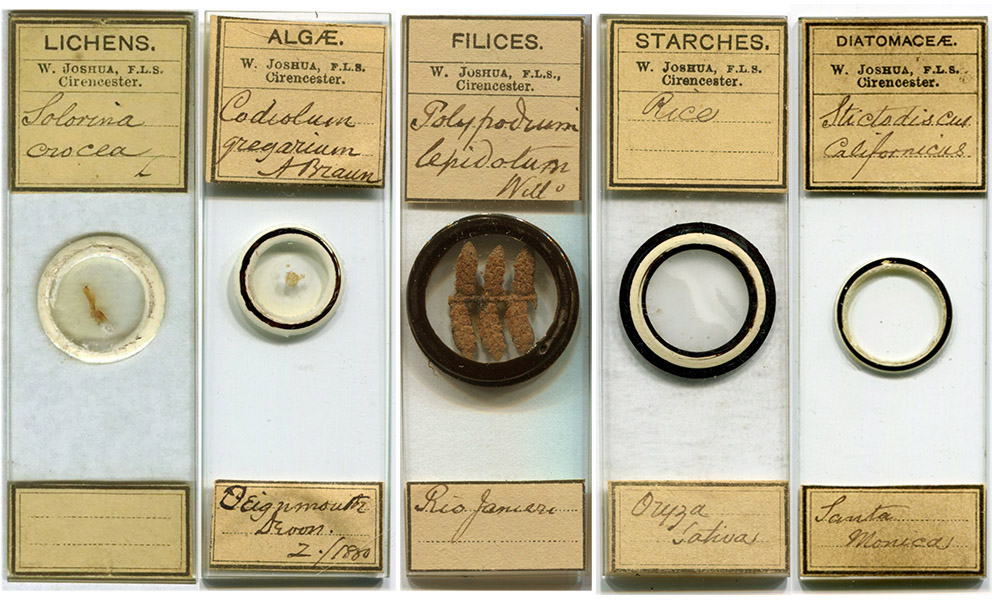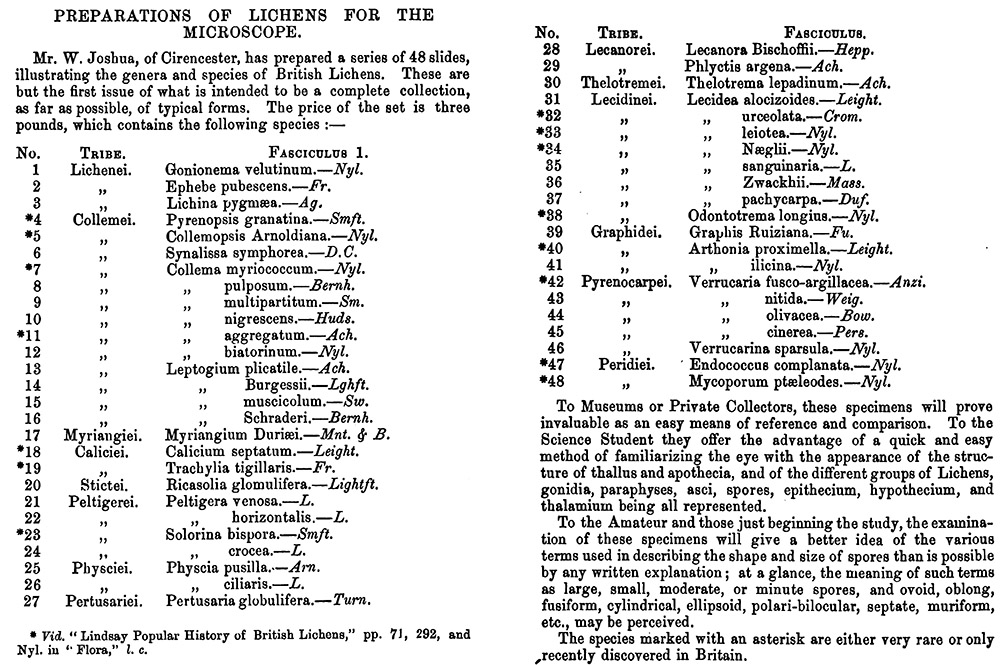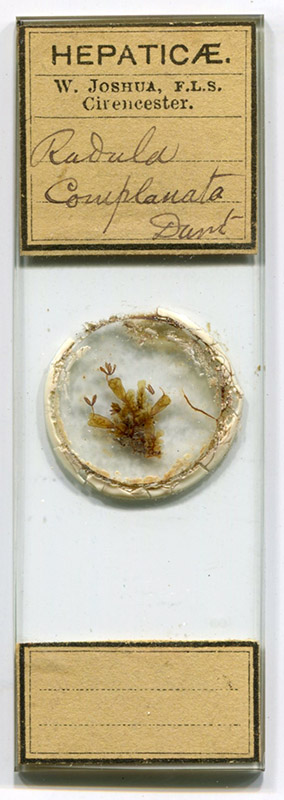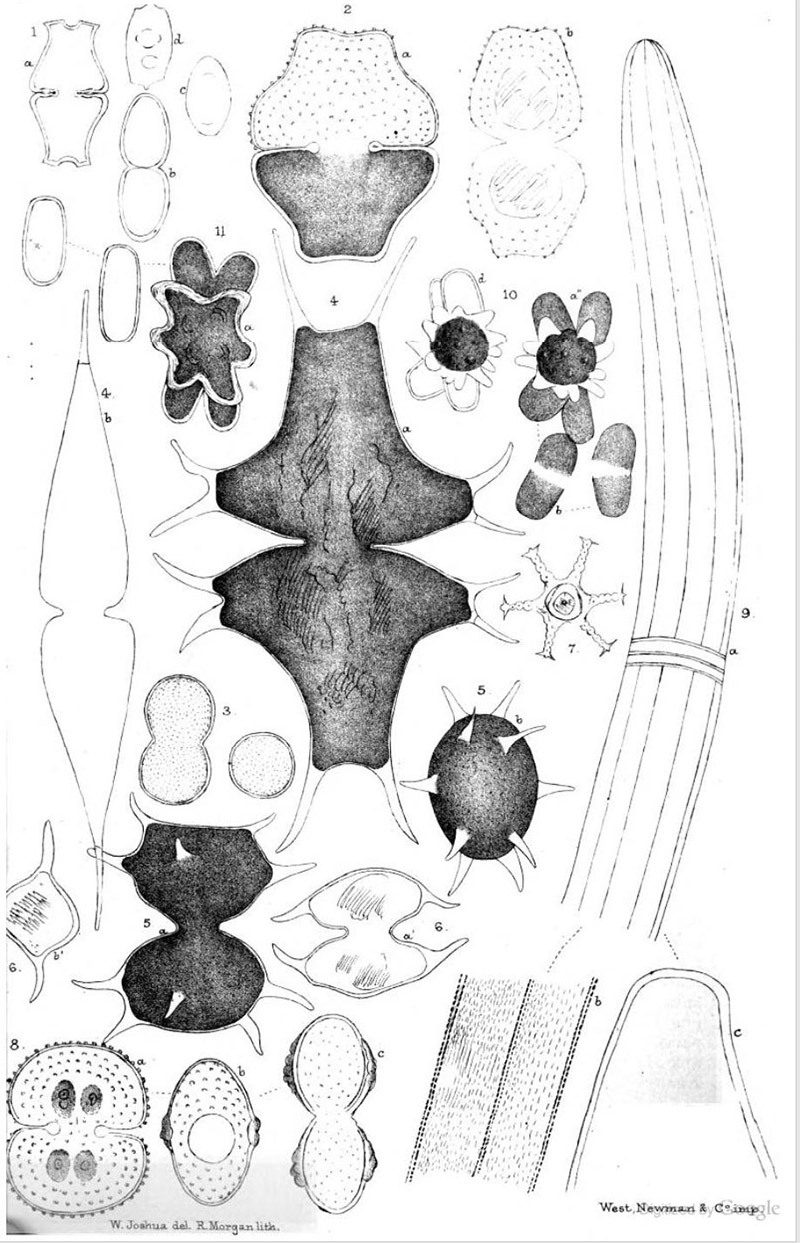William Joshua, 1828 – 1898
by Brian Stevenson
last updated December, 2018
William Joshua was an amateur naturalist, particularly interested in lichens and desmids. In 1879, he began to commercially produce a series of microscope slides on British lichens (Figure 1). This was evidently successful, and soon issued series on hepaticae, algae, and fungi. Judging from surviving slides, other series included starches, ferns (felices), desmids, and diatoms. Known Joshua slides have light brown labels with the series and “W. Joshua, F.L.S., Cirencester” in type, and the specimen description in what is presumed to be William’s handwriting. Records suggest that Joshua ceased producing these slides by the mid-1880s.

Figure 1.
Examples of microscope slides produced by William Joshua, ca. 1880s. The “algae” slide is dated 1880. The “felices” (fern) slide is a deep, dry-mount, the others used a mountant. Joshua also issued slide series of hepaticae, fungi, and desmids.

Figure 2.
An 1879 announcement of Joshua’s lichen series of microscope slides, from ‘Grevillea’. At that time, lichens were Joshua’s main topic of study, and an obvious choice for his first slide series.

Figure 3.
Advertisement from an April, 1880, issue of ‘Nature’, announcing several new series of Joshua’s slides.

Figure 4.
Many of the slides produced by William Joshua have deteriorated over time, with retracted mountant and distorted specimens. This was due to the mounting methods employed by Joshua. An 1899 essay on mounting desmids noted, “The well-known slides mounted by Mr. Joshua of Cirencester … were sealed with zinc cement, and very few of them now survive. Some of them were sent to me about a year ago … of which I managed to save four by the application of fresh glycerine and gold-size. In most of these once beautiful slides, the zinc cement has chipped away and the mounting medium has escaped, or evaporated”.
William was born in London on August 13, 1828, to Francis and Maria (nee Deane) Joshua. A brother named Francis William had been born a year earlier, but died at only 5 months old. Another brother, also named Francis, was born in 1830, and lived for a little over 1 year. Two subsequent children, Margaret and Maria, survived childhood. William’s father and grandfather, both named Francis, were grocers on Regent Street, London. To judge from the amount of money that was evidently possessed by the family, the Joshuas were not merely keepers of a modest grocery shop.
Due to William’s father and grandfather having the same name, there is some uncertainty in putting together William’s early years. Pieces fit best with the following chronology. William’s family moved to Dorking, Surrey, and his father died there in late 1837. The 1841 census recorded William’s mother, Maria, and his two sisters living at The Oval, Dorking, Surrey, attended by a governess and a domestic servant. William’s whereabouts in 1841 have not been identified, but he was likely at a school or living with relatives. Grandfather Francis had moved to Cirencester, Gloucestershire by 1838, and he died there in 1840.
In 1851, William, his mother, and two sisters had moved to Gloucester Street, Cirencester, Gloucestershire. They had a cook and house maid. Mother Maria was listed as head of the house, while William was acknowledged as “holding 113 acres, employing 5 laborers”. The best explanation for the situation is that William’s grandfather had retired to Cirencester as a gentleman farmer, then bequeathed the property to William.
The Joshuas were members of the Society of Friends (Quakers), and births, burials, and marriages of William’s parents, brothers, and sisters were listed in Quaker records. William broke with that denomination, and married Caroline Henrietta Lediard at the Cirencester Parish Church (Church of England) on “Easter Tuesday”, 1852. At that time, William lived in the area of North Cerney and Perrott’s Brook, just north of Cirencester. That was probably the expansive farm where he, Caroline, and their family lived in 1861. That year’s census listed William as being a “farmer of 406 acres employing 10 men, 3 boys and 5 women”. The farmhouse was also attended by two servants.
The gentleman farmer life ended during the next decade, with the 1871 census listing the Joshuas as living on Tower Street, Cirencester, and William working as a “traveller”. That usually meant a travelling salesman. I could not find any clues on what William was selling.
Records indicate that William had developed a strong interest in biology by the early 1870s. George Davies reported in 1874 that William Joshua had supplied him with a sample of the lichen Collema stygium. Davies’ paper on that and other lichens was entitled “Some cryptogams from Piedmont and Nice”, implying that Joshua had visited those regions of France and Italy. Also in 1874, J.M. Crombie published “Recent additions to the British lichen flora”, which included descriptions of three additional species of Collema collected by Joshua.
In 1875, Joshua published “On the Collemei of the Cirencester or Cotteswold district”, consisting of a description of the area and a list of lichens he had found near his home.
William Joshua joined the Linnaean Society on November 5, 1877 (the initials F.L.S. on his slide labels indicate “Fellow of the Linnaean Society”). He joined the Royal Microscopical Society in 1879.
Joshua initiated plans for his first series of commercial microscope slides in 1878. He was joined in this venture by Edward Morell Holmes (1843-1930), an established scientist who specialized in lichens and algae. Morell was based in London, and was undoubtedly important for making connections with customers. In the summer of 1878, they published the announcement, “Messrs. Joshua and Holmes propose, if a sufficient number of subscribers can be found, to issue a series of microscopical slides, illustrating the principal Families, genera and subgenera of Lichens; and, if the enterprise meet with success, to follow this by a series of specimens of Lichens of which no figures have been published. The specimens will be as typical as can be procured, and will consist of sections of the apothecia, showing all the various parts; they will be very useful to those commencing the study of cryptogamic botany. For further particulars apply to Mr. Joshua, Cirencester; or Mr. Holmes, 30, Arthur Road, Holloway, N”. The response must have been positive, because the lichen collection was announced in June of 1879 (Figure 2, above).
Slides of algae, fungi, hepaticae and others were made available by 1880 (Figure 3, above). An 1882 advertisement in Hardwicke’s Science-Gossip stated, “A few sets of the British Desmideae for disposal, showing well their Structure and Mode of Reproduction, and comprising many of the New and Rarer Species. Price £3 for 54 slides. Apply W. Joshua, F.L.S., Cirencester”. That phrasing may indicate that Joshua was ending his slide-making venture. Mordecai Cooke’s 1885 Ponds and Ditches stated that, “small collections of mounted specimens of fresh-water Algae and other plants ready for examination under the microscope” could be purchased from William Joshua. It is not known whether the information in Cooke’s book was accurate at the time of publication, but this was the latest reference yet found about Joshua selling microscope slides.
Desmids appear to have replaced lichens as Joshua’s chief interest in the early 1880s. Two exchange ads were published in Hardwicke’s Science-Gossip in 1882, “Wanted, British or foreign correspondents for the interchange of specimens of Algae, including the Desmideae. For particulars apply to W. Joshua, F.L.S., Cirencester”, and “Mountain or rock gatherings of Desmidia: desired (British or extra European), in exchange for others, mounted or unmounted.—W. Joshua, F.L.S., Cirencester”. He published several desmid-related papers over the next several years: “Notes on British Desmidieae” (1882), “Notes on British Desmidieae - no. 2” (1883), “On some new and rare Desmidieae” (1885), and “Burmese Desmidieae, with descriptions of new species occurring in the neighborhood of Rangoon” (1886).
The 1881 census showed the 51 year-old William Joshua to be retired (“no occupation - income from funds”), and living with Caroline and two of their children at 15 Gosditch Street, Cirencester. Caroline died in December, 1885. Shortly thereafter. William moved to Devon – the 1891 census recording him as a “boarder” who was “living on his own means” in that town. William moved back to Gloucestershire before he died, possibly to be with his children. He passed away on January 18, 1898, at the age of 69.

Figure 5.
Drawings of desmids by William Joshua, from his 1885 paper “On some new and rare Desmidieae”.
Acknowledgement
Many thanks to Michael Dingley for generously sharing information on the life and works of William Joshua, and Ted Bernhardt for sharing images.
Resources
Botanical Journal of the Linnaean Society (1891) List of members, Vol. 28, page 20
Bracegirdle, Brian (1998) Microscopical Mounts and Mounters, Quekett Microscopical Club, London, pages 58 and 150, and plate 23-F (note: there are no records of William Joshua having a middle name - the suggested middle initial “J.” on page 58 may have been a typographical error)
Bryan, G.H. (1899) Desmids, Science-Gossip, Vol. 6, pages 359-360
Cooke, Mordecai C. (1885) Ponds and Ditches, Society for Promoting Christian Knowledge, London, pages 64-65
Crombie, J.M. (1874) Recent additions to British lichen flora, Journal of Botany, New series, Vol. 3, pages 146-147
Dalton, Catherine (2000) Limerick birthplace of William Henry Harvey, which includes “In 2000, a historical microscope slide collection of mosses, lichens and algae was discovered in the Geography Department of Mary Immaculate College along with a range of antique brass microscopes. The slide collection was assembled by William Joshua (1828-1898) a contemporary of Harvey. The collection contains 350+ microscope slides composed of 150 algae, 100 lichens, 40 marine algae and 26 fungi. Joshua is a less well known phycologist whose work has largely been forgotten. He worked on the geographical distribution of desmids, particularly in South East Asia. The pinnacle of his work came between 1882-1886, in a collection of papers based mostly on British and Asian desmids. In these essays he described 142 rare or news species, 11 of which were sent to him from foreign correspondents. The last of these papers was the most significant, describing some 38 new desmid species and 8 new varieties in Asia, demonstrating his influence on desmid taxonomy”, The Phycologist, number 87, pages 28-29
Davies, George (1874) Some cryptogams from Piedmont and Nice, Grevillea, Vol. 2, pages 173-174
Dingley, Michael (2003) William Joshua F.L.S., the unknown desmidologist, Biologia, Bratislava, Vol. 58, pages 723-727
England census, birth, marriage and death records, accessed through ancestry.co.uk
The Farmer’s Magazine (1862) “List of Prizes … Common Turnips, First Prize, 2 Guineas, The Duke of Sutherland, Trentbam, Staffordshire. Second, 1 Guinea, Mr. William Joshua, Perrott's Brook, Cirencester”, pages 45-46
Grevillea (1879) Preparations of lichens for the microscope, Vol. 7, pages 145-146
Hardwicke’s Science-Gossip (1882) Exchange offers and advertisement from William Joshua, Vol. 18, pages 48, 240, and vii
Holmes, Edward Morell (1878) Holmes’ Botanical Note Book, Christy & Co., London
Joshua, William (1875) On the Collemei of the Cirencester or Cotteswold district, Grevillea, Vol. 4, pages 42-43
Joshua, William (1878) New British Riccia, Grevillea, Vol. 6, page 104
Joshua, William (1885) On some new and rare Desmidieae, Journal of Botany, Vol. 23, pages 33-35
Journal of Botany (1878) Botanical news, Vol. 16, page 320
Kelly’s Directory of Gloucestershire (1885) “Joshua, Wm. F.L.S., 15 Gosditch st. Cirencester”, page 318
A List of the Country Banks of England and Wales. Private and Proprietary: also of the Names of All the Shareholders of Joint-Stock Banks (1838) “Joshua, Francis, Cirencester”, M.A. Marchant, London, page 153
Nature (1880) Advertisement for William Joshua’s microscope slides, Vol. 21, advertising sections of April 1, 8, 15, and 22
The Poultry Chronicle (1855) “Pure Aylesbury duck’s eggs, 6s. per setting, including package. Pale Buff Cochins, perfectly clear hackle, 12s. Silver Spangled Hamburgs, 8s. for 15 eggs. The stock on sight on application to Wm. Joshua, Esq., Perrott's Brook, Cirencester”, page 143
Probate of William Joshua (1898) “Joshua William of 32 Montpellier-terrace Cheltenham gentleman died 18 January 1898 Administration London 25 February to Francis William Joshua physician and surgeon Effects £1038 13s 10d”, accessed through ancestry.co.uk
Proceedings of the Linnaean Society of London (1886) “February 18th, 1886 … There was exhibited, for Mr. William Joshua, a series of over 130 specimens of Lichens from Jamaica, these having been collected and preserved by Mr. J. Hart, of Gordon Town, and afterwards identified by Dr. J. Miller (Arg.) of Geneva. A mounted set of some of the rarer and most interesting of the above were shown under low powers of the microscope”, pages 125
West, W., and G.S. West (1904) A Monograph on the British Desmidiaceae, Vol. 1, Ray Society, London, list of W. Joshua publications of desmids, page xxiv




